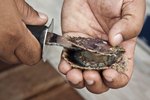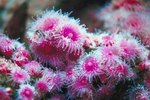
Caring for pygmy seahorses breaks every saltwater aquarium rule: You want to get the smallest tank you can; high-quality live rock is a bad idea; and they breed readily in captivity. Nonetheless, pygmy seahorses require meticulous care.
Selecting The Tank
Usually for a saltwater aquarium, any aquarium with capacity below 30 gallons is considered dangerously cramped. However, for a pygmy sea horse, a tank with capacity of 10 gallons is the largest you should consider -- and it should be that large only if you plan on keeping a group. In larger tanks, dwarf seahorses have a hard time finding food and tend to get lost. You should keep a pair in a tank of 2.5 gallons and a group in a tank of 5 to 10 gallons.
Decorations
Never use live rock, and never use decorations from an established aquarium. Many aquariums contain hydroids, tiny jellyfishlike cnidarians. To most fish, these are harmless -- often, they're snacks. But they can be dangerous to pygmy seahorses. Instead, use dead rock like tufa rock. Also, do not include corals since most cannot thrive under the conditions a pygmy seahorse tank requires. Use fake coral and seaweed if you desire such elements. Make sure you include branching structures for the seahorses to perch on.
Equipment
Dwarf seahorses need some specialized equipment. Since their tanks are so small, you may want to plumb the tank to a sump filter. A sump filter consists of a tank connected to the aquarium by gravity plumbing and aquarium pumps. You can hook other equipment up to the sump to save room in the main aquarium. This equipment should include a protein skimmer and a standard aquarium heater. Make sure the water movement is not too strong; dwarf seahorses are weak swimmers.
Cycling
Pygmy seahorses are very sensitive to ammonia in the aquarium. In a healthy, established aquarium, nitrifying bacteria eat ammonia and convert it to nontoxic compounds. To establish colonies of these bacteria, you will have to use a process called fishless cycling a few weeks to a month before you set up your tank. In this process, you will test the water daily, adding drops of household ammonia to gradually achieve a level of 4 to 5 parts per million of ammonia. Once your tank can go from 5 ppm of ammonia to undetectable levels of both ammonia and nitrite in 12 hours, your tank is almost ready. Test for nitrate and if the levels are greater than 20 mg/l (20 ppm), perform a 25 percent water change.
References
Resources
Photo Credits
-
Medioimages/Photodisc/Valueline/Getty Images


